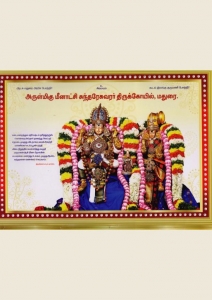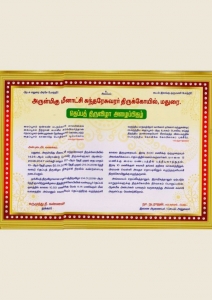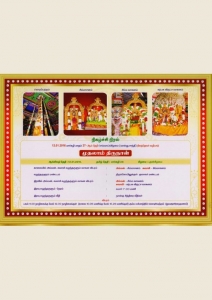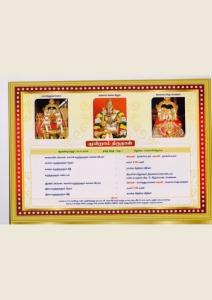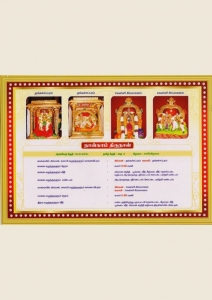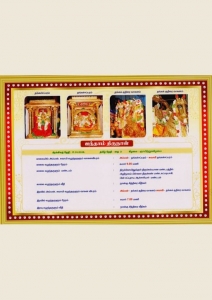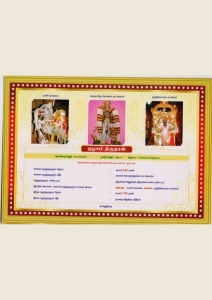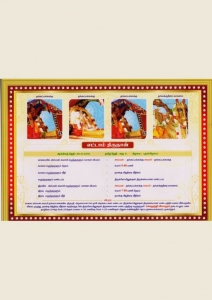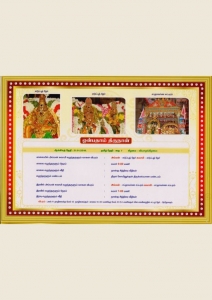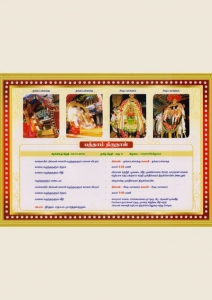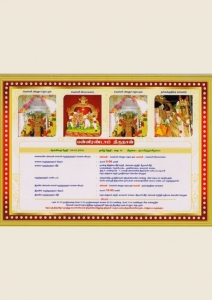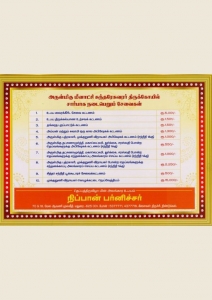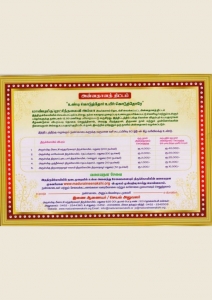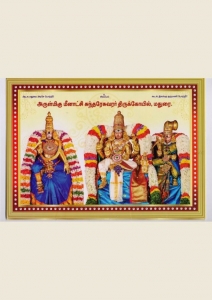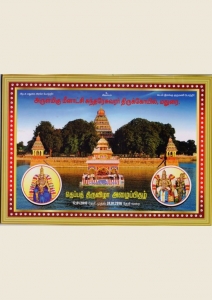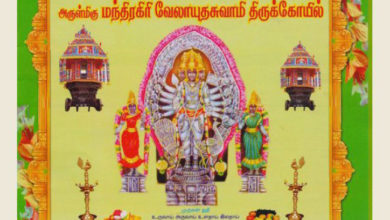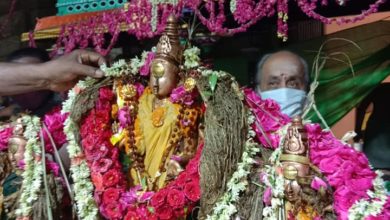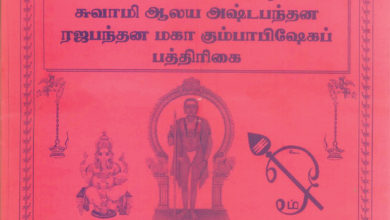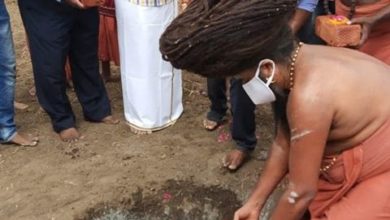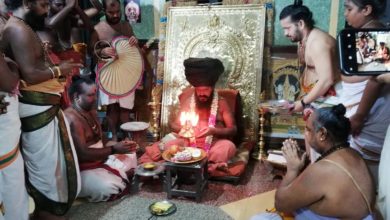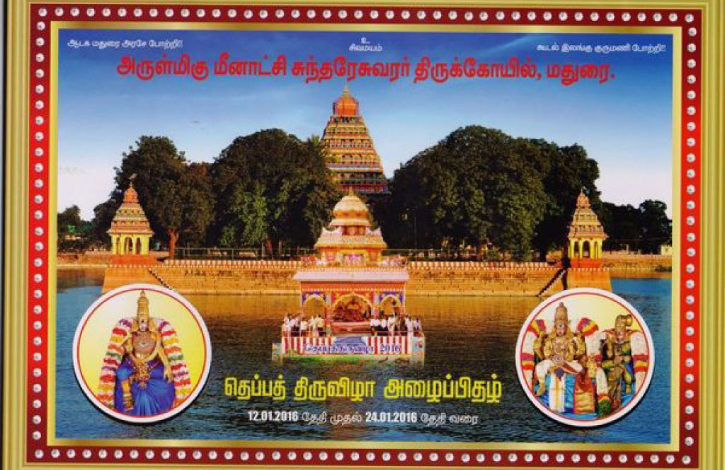
Madurai Meenakshi Sundareswarar Temple Theppam Festival 2016
Madurai Meenakshi Sundareswarar Temple Theppam Festival 2016
Moolavar : Sundareswarar, Chokkanathar
Amman / Thayar : Mennakshi, Angayarkanni
Thala Virutcham : Kadamba tree
Theertham : Pottramarai, Vaigai, Kruthamalai, Teppakulam, Purathotti
Agamam / Pooja : Karana Agamam
Old year : 2000-3000 years old
Historical Name : Alavai, Kudal, Nanmadakudal, Kadambavanam
City : Madurai
District : Madurai
State : Tamil Nadu
Singers:
Madurai Meenakshi temple is praised in the Thevaram hymns of Gnana sambandar and Tirunavukkarasar. Saint Sambandar, in the Alavai Pathigam (10 verses on Alavai-Madurai) speaks the greatness of the sacred ash-Vibuti. “The sacred ash of Alavayan – Lord Shiva with Mother Uma as part of His body – is all effective words of Mantras, the celestial beings have it, it is all beauty, it is worshipped, it is a vedic constitution and is in our religion.” Aalavai-Madurai is the first sacred land of Pandya region sung in Thevaram hymns.
Festival:
Madurai Meenakshi: The famous Chithirai Tiruvizha in April-May has many programmes as Wedding of Mother Meenakshi with Lord Shiva, Her Coronation and car festivals. Navarathri in September-October, Aavani Moola festival in August-September, Thai float festival in January-February, Aadi Pooram in July-August, Pongal in January-February, Deepavali, Tamil and English New Year days, Vinayaka Chaturthi are other festivals. There are monthly special pujas also. Almost every day is a festival day in the temple.
Temple’s Speciality:
Madurai Meenakshi: The Vimana in the shrine of Sundareswarar is gifted by Indira the King of Devas. He was on a pilgrimage to various Shiva temples to cleanse himself of a killing sin. His sins disappeared when he found a beautiful Swayambulinga in this place praised as Kadamba Vanam – a forest dense with Kadamba trees. It is said that as a token of his gratitude to Lord Shiva, he built this temple with Indira Vimana. This temple enjoys a special importance among the 51 Shakti Peetas in the country, named Rajamadhangi Shyamala Peetam. The idol of Mother Meenakshi is made of pure emerald stone – Maragatham stone. This is also the land of Sundaranandar, among the 18 Siddhas. This is the first temple among the 366 Shiva temples in Tamilnadu in the name of Meenakshi Sundareswar. The land-Madurai- is revered as Kailash on earth –Bhooloka Kailasam. Chanting the very name of Madurai ensures salvation to the devotee. In his celebrated Meenakshi Amman Pillai Thamizh, Saint Kumaraguruparar, mentions this place as Dwadashantha Sthalam and Shiva Rajadhani, capital of Shiva Kingdom. Pottramarai Kulam – Tank of Golden Lotus: This was created by Lord Shiva by hitting the earth with His trident responding to the request of Nandhi and other Devas. This is first among the holy springs of the temple, also called Shiva Ganga. Indira got the golden lotus from here only for his Shiva puja. The devotee will achieve all his wishes if he/she has a dip in the tank especially on holy days as new moon day, first day of Tamil months and the eclipse day and worship the Lord. All the 64 incidents related to Lord Shiva’s grace to His devotees are painted on the walls around the tank. And this is the tank where the Sangam Seater (Sanga Palakai) appeared in recognition of the Tamil Veda the Tirukkural.
Opening Time:
Madurai Meenakshi temple is open from 5.00 a.m. to 12.30 p.m. and from 4.00 p.m. to 10.00 p.m.
Address:
Sri Meenakshi Sundareswarar Temple, Madurai – 625 001.
Phone:
+91- 452-234 9868, 234 4360
General Information:
Meenakshi temple: The name of Mother-Goddess is Meenakshi, which in chaste Tamil is known as Angayarkanni, meaning her eyes are in the shape of a fish. As the fish protects its eggs with its eye sight, so protects Mother Meenakshi Her devotee with a very look of Her eyes. The fish does not have eye lash, so the eyes never close and ever open. Similarly, Mother never closes Her eyes and keep them ever open day in and day out without twinkling to take care of Her devotees. (Unmesha nimishodhpanna vipanna bhuvanavali-Sri Lalitha Sahasranama).
Mother Meenakshi has many names as Pachai Devi, Maragathavalli, Thadathagai, Abishekavalli, Abhiramavalli, Kayarkan Kumari, Karpooravalli, Kumari Thurayal, Komagal, Sundaravalli, Pandipiratti, Madurapuri Thalaivi, Manickavalli, Mummulai Tiruvazhumagal.
Lord Nataraja changing legs in dance: The divine wedding of Mother Meenakshi with Lord Shiva was going on in a grand way. The divine couples invited the Devas and Maharshis for lunch. Sages Patanjali and Vykrapada told the Lord that they use to eat only after seeing His dance in the Golden Hall-Ponnambalam. This is in Chidambaram. With a view to respect the principle of the Rishis, Lord created a Silver Hall (Velli Ambalam) in the Meenakshi Amman Temple itself and performed His divine dance. Their joy knowing no bounds, the Rishis enjoyed the wedding lunch also.
Rajasekhara Pandian, son of Vikrama Pandian who ruled Madurai was a master of 63 of the 64 arts, the one remaining was dancing. He thought that while Lord Nataraja is ever dancing, how he could learn the art. Meantime, he came to know that Karikal Chozha, his counterpart in Chola kingdom, was a master of all the 64 arts including dancing. Pandian decided that he too learn this art and experienced the pain of learning dancing. Happy with his mastery over all the arts, he came to Lord Shiva seeking His blessings. Experiencing the pain during the practice of art, he thought how the Lord could endure this pain as He is dancing for ever without any break. He wondered how the Devas and Rishis never thought of this difficulty of the Lord. He was hesitant to put this question to Lord when great souls remained mute.
Shivrathri came. After completing four pujas, Rajasekhara Pandian stood before the Lord and spoke with tears, “Oh! Lord, you are dancing on only one leg for long. Can’t you change the leg for me? If you don’t, I shall plant my sword before you and fall on that and end myself.” So saying, he closed his eyes in meditation. When he opened his eyes, he was excited to see the Lord dancing with His right leg pressing the left on the stage. Lord could not see His devote suffering from any reason. The king sang in praise of the Lord’s response to his prayers. He also secured a boon from the Lord that he would stay in Madurai in the same dancing form.
In his celebrated Epic Tiruvilayadal Puranam, inspired poet Panjothi Muniver describes this episode very beautifully in the 24th Chapter. This is the 6th of the 64 Tiruvilayadals (graceful incidents) of Lord Shiva.
Lord the Siddha: During the rule of Abhisheka Pandian, Lord Soma Sundara-Meenakshisundara was going round the parts of Madurai doing miracles in the guise of a Siddha. He made the aged a youth, man the woman, iron to gold, lame to run, dumb to sing, dancing on a needle by the toe and many such bone chilling acts. Informed of the miracles happening in the city, Abishek Pandian summoned Siddha to his court. As those who went to Siddha did not return, the king sent his minister. The Siddha told the minister that he had no use of the king and said that the king may come to see him if he so desires.
Knowing that the king was coming to see him, the Siddha entered Meenakshi Temple and went into deep meditation facing northwest. (The place where the Siddha went in is in front of the Durga shrine on the Meenakshisundareswarar shrine prakara). The king’s men could not disturb the meditation of the Siddha and their raised hands simply stood up as it were.
The shocked king spoke to Siddha and offered his wishes if any. Siddha opened his eyes and said that He was all in the universe and that he was the origin and end of the world moving everywhere. “I give my people the boon they wish. I am a siddha of supreme capabilities.” The king asked the siddha if he could make the stone elephant eat the sugar cane in his hand. Siddha just cast his look on the stone. In fraction of a second, the statue got life, picked not only the sugar cane and ate it but also snatched the jewel on the chest of the king. The king fell at the feet of the Siddha-Shiva, sought his pardon and child boon. The king was blessed with a son. The Siddha was known as Sundaranandar.
Expressing their gratitude to the Lord, devotees build flower tents and worship the Siddha. Murthy Nayanar, born in a trader community on Kruthika star day in the month Aadi (July-August) and belonging to the congregation of 63 Saivite Nayanmars was serving the Lord by grinding sandal for His pujas. Madurai was then under the rule of a king who was a coward. Taking advantage of the weakness of the country, Karnataka king invaded Madurai, defeated the king and had Madurai as his capital. As a Jain, he began to harass Shiva devotees, brought the Gurus to spread Jainism. He prevented the growth and spread of Saivism and did not allow renovations of temples. He also prevented supply of sandalwood to Murthy Nayanar.
Though Nayanar could not get sandalwood for Lord’s puja, he ventured to use his hand as sandalwood and began to grind. He began to bleed. Bones were damaged. Pleased with the steadfast devotion of Nayanar, Lord appeared before him and suggested to wage a war against the Karnataka king, recover the land from the enemy and ensured salvation to him. Nayanar’s hands were immediately cured. Karnataka king’s end also came in. His rule too came to an end. Saivism got a new lease of life. Karnataka king had no heir to succeed him. As was the custom then to choose a king, ministers of Madurai gave a garland to an elephant. The one garlanded by the elephant shall be the king of the region. Murthy Nayanar was the choice of the elephant. Nayanar refused to accept precious jewels and offered to rule the city wearing only Rudraksha, sacred ash the Vibuti etc. The land was prosperous under Nayanar’s rule. After long years of service to the subjects of the region, Nayanar attained the Lotus feet of Lord Shiva.
This is a temple speaking volumes of the glory of Tamil culture and arts with live statues and idols, stones singing and great literatures produced by eminent scholar poets. There are live paintings all over the temple depicting the Tiruvilayadals of the Lord. Prose, poetry, plays all three forms of Tamil language – Iyal, Isai, Natakam reached the peak of glory.
It is here that Pottramarai Kulam – the tank with golden lotus came into being offering flowers to Indira for Shiva puja. There are no fish or water creatures in the tank. There are temples on four directions within the Madurai city known as Inner Aavaranas. There are also four temples on the outer limits of the city. Tiruparankundram on the east, Tiruvedagam on the west, Tiruvappanur on the North and Tirupuvanam on the south are these Temples. The inner Aavaranam consists of Chokkanathar temple worshipped by Kubera, the temple where Lord worshipped himself-Immayil Nanmai Tharuvar temple- Iravadhanallur Muktheeswarar Temple worshipped by white elephant Iravadham and the Then Tiru Alavai temple worshipped by Yama the God of Death.
Prayers
Mother Meenakshi grants everything the devotee wishes in life – happy wedding, children, prosperity, health, longevity and all their just needs. Devotees simply place their prayers at Her Lotus Feet.
Lord Chokkanathar-Meenakshi Sundareswarar assures all peace of mind and total salvation to the souls. The corridor of the temple is a convenient and comfortable spot for meditation. All can hear the divine sound Ohm. One can see a flood of devotees in the temple at all times.
Thanks giving:
Devotees perform abishek with milk, oil, green coconut, sandal etc. They undertake all types of fasting. Any righteous ritual including donations, poor feeding, penance, meditation etc. bring the devotee manifold benefits. Devotees offer silk saris to Mother and vastra to Lord.
Greatness Of Temple:
Madurai Meenakshi is globally famous. Religious and political history of Tamilnadu begins from here. Mother Meenakshi sets an example of fair administration. Lord Shiva is all to all. A temple worshipped by great saints. This is the sacred land where Lord Shiva danced changing his legs. Indira and Varuna worshipped here. As this the first of the 64 Shakti Peetas in the country, all pujas are first dedicated to Mother Meenakshi and then to Lord Shiva.
This is the place where a heated argument took place in the court of King Shenbaga Pandiyan about the meaning of a poem, the Lord defending poet Tharumi and got him the golden purse. This is the place that respected the freedom of expression through poet Nakkeeranar telling the Lord face to face that a poetic mistake cannot be justified by showing His eye on the forehead thus threatening his right.
Madurai is the place where Saivite Saint Tirugnanasambandar established the glory of Saivism by defeating the Jains through water and fire tests (Punal Vadam and Aunal Vadam). Lord came to the rescue of an old lady Vandhi as her coolie to patch the breach in Vaigai and received the cane blows from King Arimardhana Pandian. The temple is ever active with some festivals each day with fragrance of divinity filling the environment. A place of exquisite beauty of sculpture and painting making the temple a treasure of arts related to divinity.
Praised as Shivarajadhani, capital of Shiva Kingdom, the city planning of Madurai is unmatched. The temple has five entrances and 14 towers with the South Tower being the tallest. The Thousand Pillared Mahamandap is near the north tower. There are five musical pillars. There are also many statues sounding music. This is the biggest part of the temple. There are 985 pillars. The idol of Lord Nataraja is in the centre of the Mandap. Lord Shiva is a swayambumurthy. Of the five Sabhas where Lord performed His cosmic dance, Madurai Sabha is known as Rajatha (silver) sabha where the Lord changed the legs. This dance is called Sandhya Thandavam. The 7 feet tall Mukkuruni Pillayar-Lord Vinayaka was found from the Mariamman Teppakulam-tank. There are no fish or water creatures in the Pottramarai tank, due a boon granted to a crane by Lord Shiva.
Multi-purpose information centre: The Department of Hindu Religious and Charitable Endowments (HR & CE) has established a Multi-Purpose Information Centre at the temple at a cost of Rs. 5 lakh with a view to disseminating information on all temples in the state in three languages for the convenience of north Indian devotees and foreign tourists. The centre is set up near the Amman Sannidhi entrance on the eastern side of the temple. There will also be a topographical map, which would provide the location of all important areas in the temple, near the South tower entrance.
A person, fluent in Hindi and competent in handling computers is being recruited to manage the centre. Information on puja timings of all temples in the state besides logistical details and availability of accommodation will be made available to the devotees. A touch screen system providing all information on the Meenakshi emple such as its history, significance, festivals and important events would be installed.
Silver doors for ‘Palli Arai: The ‘Nattukottai Nagarathar Sangam has come forward to install a door made out of pure silver for the ‘Palli Arai’ of Mother Meenakshi. They bear the entire cost of the door being made out of 70 kilograms. The Nattukottai Nagarathar samgam is making the door themselves.
Temple History:
Meenakshi temple: King Malayadwaja Pandya and his queen Kanchanamala performed Puthrakameshti Yaga seeking child boon. Mother Uma rose from the Yaga fire as a child with three breasts. While the king stood shocked at the appearance of the child with three breasts, a voice said that one will disappear when married. As advised, the child was named Thadathagai. She grew mastering all arts.
After Malayadwaja Pandia, Thadathagi ascended the throne and gave good governance to Her people. She reached the marriageable age. Thadathaga set out with Her army to conquer regions including Mount Kailash where she fought with Shiva too when one of her breasts disappeared. She understood that the Lord was her husband. Marriage was arranged. Lord Vishnu, devas, Rishis attended the divine wedding. Brahmma the Creator conducted the marriage as per Vedic rules. Lord Shiva tied the wedding knot to Mother on Panguni Uthira star day – March-April. Indeed, those who had the rare opportunity of being the guests for the divine wedding were blessed lots.
Lord Shiva assumed charge of the government. The Bull Flag was replaced by a flag with Fish symbol. He assumed the name of Soma Sundara – Soundara Pandya. His Shiva Ganas came to earth as humans. Lord Shiva was a kind king to ordinary humans, a lion to enemies and a Guru to ascetics.

